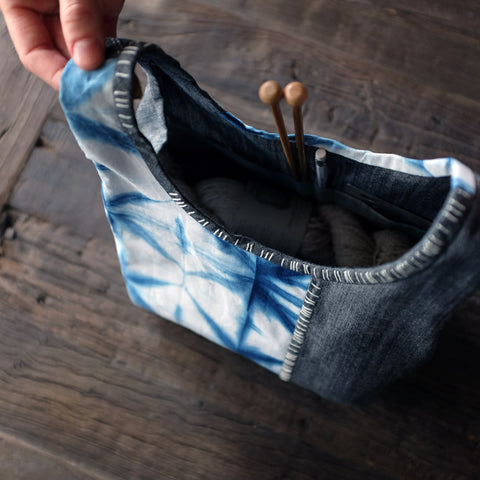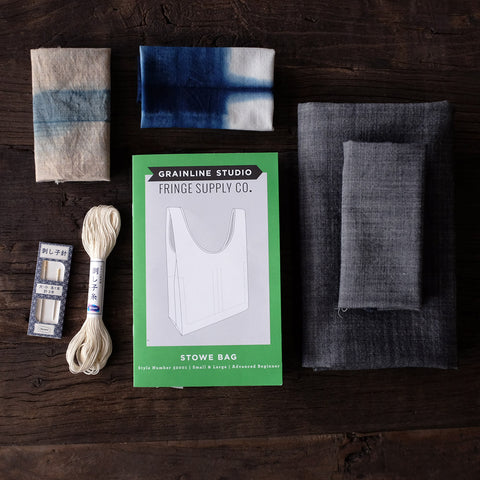In 2001, I worked for the Textile Museum in Washington D.C. and was exposed to some of the most beautiful textiles in the world. It was a never-ending journey of discovering new textiles, the techniques used to make them, and about the people who made the textiles and the places around the world where they were made. My world grew exponentially.
One day, I came to work and a new exhibition had opened: Japanese Fisherman's Coats of the Awaji Island. Along the gallery walls, twenty-two indigo-dyed coats hung. Along the surface of the coats were intricate patterns of geometric designs hand-stitched with white cotton thread. They were absolutely gorgeous. As with most textiles, there are three concepts working as one: form, function, and beauty. The coats were made of multiple layers of fabric, to keep the fisherman warm and dry. They were held together with the stitching. And the patterns stitched upon the cloth added beauty and elegance to the jacket. These intricately stitched patterns are known as sashiko. I immediately wanted to know more about sashiko and as I began my research I ran into another amazing Japanese textile tradition called boro.
Before getting into Boro, we have to go backwards before we can forwards, and we must look at indigo. At the root of both the sashiko and boro traditions lies indigo dyed cloth. Indigo is a blue dye derived from an indigo-bearing plant. There are hundreds of varieties of plants which create indigo pigment, though there are only a handful of plants which create enough indigo pigment to warrant the labor and time intensive process of extracting the pigment from the plant. Indigo is planted in March, harvested multiple times throughout the Summer, amassing, to begin the composting process through the Fall and Winter, and can finally be used the following Spring to dye through a fermentation process.
Indigo is believed to have come to Japan sometime in the 5th century from China. At first, indigo was only used by royalty. As advancements in agricultural production occurred and the indigo dyeing process became more streamlined, indigo dyed fabric became available to the masses and was revered. Before farming and manufacturing was mechanized, as it currently is, cloth and clothing was highly revered. It was common to own only a few pieces of clothing and for this clothing to be patched as needed. For those who were very poor, it was common to take indigo-dyed fabric scraps and rags and to use them to patch their clothing. Sometimes the clothing had so many patches, the clothing began to look like patchwork. This raw style became its own genre of textiles called boro which means ragged in Japanese. Today, these textiles in their immediacy are thought of as poetic and are highly sought after.

From the moment we, at Verb, laid eyes upon the Stowe Bag sewing pattern (by Grainline Studio and Fringe Association) - we've been smitten. We always love a good project bag - and this is certainly one of the best around. Hint: It has internal pockets.
The pattern has two sizes, and here we've sewn the small version.

Taking inspiration from the Japanese traditions of sashiko and boro, we created our rendition of the Stowe Bag - and have made a kit for you to create your very own interpretation.

Before you start your kit, you may want to peruse two Pinterest pages I created to get your creative juices flowing: sashiko and boro.

The Boro Inspired Stowe Bag Kit includes one of our very favorite lines of fabric we carry at Verb: cloth created with organic US cotton - from cotton breeder Sally Fox (from who we also source the wool used in our Horizon yarn line). We adore this fabric because of the cotton it is made from, because it is organic, and because it has a beautiful hand. For the main fabric we chose cloth which the weft is natural brown cotton (yes, it grows in that color on the plant) and the warp is white in the case of the sand kit, and dyed blue in the cases of the blue kits. Then, in order to create the patchwork style for the Boro-esque design, I indigo dyed fabric in our Oakland studio. Each kit includes two pieces of indigo dyed cloth. The kit also includes white sashiko thread and sashiko needles so you can create your own sashiko-inspired patterns.
---------------------
Tasa, our sewing teacher at Verb, sewed the blue sample shown in these photos. I asked Tasa a few questions about her process, here are her responses:
1. Do you have tips or tricks you would like to share with readers who are interested in making this project?
Tasa: Read through the pattern before starting. Be precise when cutting.
2. I noticed the Stowe Bag is unfinished inside, though yours is finished. How did you finish the inside of your bag?
Tasa: For the side of the bag that is 2 fabrics, I sewed them together using a flat fell seam before I cut out that panel. If you cut out each side of the panel and then sew it together remember to add seam allowance.
I sewed the side seams with a flat fell seam and I applied a leftover scrap of bias to the bottom seam when I sewed it.
For the bias, I cut strips @1.5", sewed them at 3/8", folded them to the inside of the bag, and slip-stitched by hand to finish.
3. How did you decide on the placement of your fabrics?
Tasa: I looked at the pieces I had and thought about how I wanted the finished bag to look. I also wanted some of the lighter color on the inside of the bag because it is MUCH easier to see what is inside your bag if the inside isn't all black!
4. If you were to do it over again, what changes might you make? (I am thinking primarily of alterations in stitch pattern or placement of fabric).
Tasa: I really like how the fabric placement turned out. I like the stitching, it might be the kind of thing where I would add more as time goes by.
5. When did you add your sashiko stitches?
Tasa: The very last thing I did was the stitching.
---------------------------Tasa is teaching a Stowe Bag class in December, sign-up here.
To purchase a kit, click here.
This kit is a limited edition due to the fact that we are almost out of this beautiful fabric and we are unsure if we will be able to create more.
We want to see your version! Please tag your Instagram photos #stowebag and #stowemeetsboro, and mention @avfkw @fringesupplyco @grainlinestudio so we'll all be sure to see!




